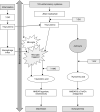Kynurenine Pathway of Tryptophan Metabolism in Neuropsychiatric Disorders: Pathophysiologic and Therapeutic Considerations
- PMID: 33124585
- PMCID: PMC7609208
- DOI: 10.9758/cpn.2020.18.4.507
Kynurenine Pathway of Tryptophan Metabolism in Neuropsychiatric Disorders: Pathophysiologic and Therapeutic Considerations
Abstract
Under physiological conditions 95% of the ingested essential amino acid tryptophan is metabolized by the kynurenine pathway (KP) to yield the ubiquitous co-enzyme nicotinamide adenine dinucleotide, fulfilling cellular energy requirements. Importantly, the intermediaries of KP exert crucial effects throughout the body, including the central nervous system. Besides, KP metabolites are implicated in diverse disease processes such as inflammation/immune disorders, endocrine/metabolic conditions, cancers and neuropsychiatric diseases. A burgeoning body of research indicates that the KP plays a pathogenic role in major psychiatric diseases like mood disorders and schizophrenia. Triggered by inflammatory processes, the balance between neurotoxic and neuroprotective branches of the KP is disturbed. In preclinical models these discrepancies result in behaviors reminiscent of depression and psychosis. In clinical samples, recent studies are discovering key kynurenine pathway abnormalities which incriminate it in the pathogenesis of the main psychiatric disorders. Harnessing this knowledge has the potential to find disease biomarkers helpful in identifying and prognosticating neuropsychiatric disorders. Concurrently, earnest research efforts directed towards manipulating the KP hold the promise of discovering novel pharmacological agents that have therapeutic value. In this manuscript, an in-depth appraisal of the extant literature is done to understand the working of KP as this applies to neuropsychiatric disorders. It is concluded that this pathway plays an overarching role in the development of major psychiatric disorders, the KP metabolites have the potential to serve as disease markers and new medications based on KP modulation can bring lasting cures for patients suffering from these intractable conditions.
Keywords: Inflammation; Kynurenic acid; Kynurenine pathway; Mood Disorders; Quinolinic acid; Schizophrenia..
Conflict of interest statement
No potential conflict of interest relevant to this article was reported.
Figures


References
-
- Tufvesson-Alm M, Schwieler L, Schwarcz R, Goiny M, Erhardt S, Engberg G. Importance of kynurenine 3-monooxygenase for spontaneous firing and pharmacological responses of midbrain dopamine neurons: relevance for schizophrenia. Neuropharmacology. 2018;138:130–139. doi: 10.1016/j.neuropharm.2018.06.003. - DOI - PMC - PubMed
-
- Majewski M, Kozlowska A, Thoene M, Lepiarczyk E, Grzegorzewski WJ. Overview of the role of vitamins and minerals on the kynurenine pathway in health and disease. J Physiol Pharmacol. 2016;67:3–19. - PubMed
Publication types
LinkOut - more resources
Full Text Sources

